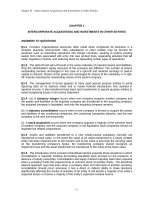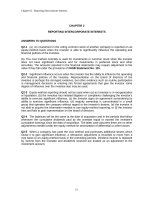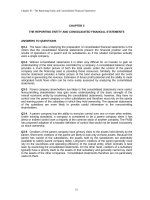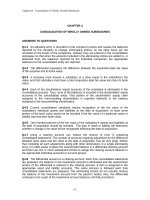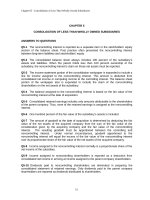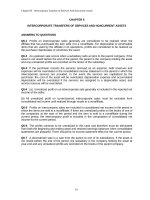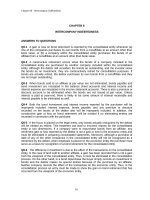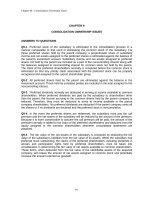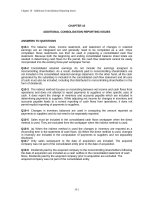Solution manual advanced financial accounting, 8th edition by baker chap002
Bạn đang xem bản rút gọn của tài liệu. Xem và tải ngay bản đầy đủ của tài liệu tại đây (154.39 KB, 45 trang )
Chapter 02 - Reporting Intercorporate Interests
CHAPTER 2
REPORTING INTERCORPORATE INTERESTS
ANSWERS TO QUESTIONS
Q2-1 (a) An investment in the voting common stock of another company is reported on an
equity-method basis when the investor is able to significantly influence the operating and
financial policies of the investee.
(b) The cost method normally is used for investments in common stock when the investor
does not have significant influence and for investments in preferred stock and other
securities. The amounts reported in the financial statements may require adjustment to fair
value if they fall under the provisions of FASB Statement No. 115.
Q2-2 Significant influence occurs when the investor has the ability to influence the operating
and financial policies of the investee. Representation on the board of directors of the
investee is perhaps the strongest evidence, but other evidence such as routine participation
in management decisions or entering into formal agreements that give the investor some
degree of influence over the investee also may be used.
Q2-3 Equity-method reporting should not be used when (a) an investee is in reorganization
or liquidation, (b) the investee has initiated litigation or complaints challenging the investor's
ability to exercise significant influence, (c) the investor signs an agreement surrendering its
ability to exercise significant influence, (d) majority ownership is concentrated in a small
group that operates the company without regard to the investor's desires, (e) the investor is
not able to acquire the information needed to use equity-method reporting, or (f) the investor
tries and fails to gain representation on the board of directors.
Q2-4 The balances will be the same at the date of acquisition and in the periods that follow
whenever the cumulative dividends paid by the investee equal or exceed the investee's
cumulative earnings since the date of acquisition. The latter case assumes there are no other
adjustments needed under the equity method for amortization of differential or other factors.
Q2-5 When a company has used the cost method and purchases additional shares which
cause it to gain significant influence, a retroactive adjustment is recorded to move from a
cost basis to an equity-method basis in the preceding periods. Dividend income is replaced
by income from the investee and dividends received are treated as an adjustment to the
investment account.
2-1
Chapter 02 - Reporting Intercorporate Interests
Q2-6 An investor considers a dividend to be a liquidating dividend when the cumulative
dividends received from the investee exceed a proportionate share of the cumulative
earnings of the investee from the date ownership was acquired. For example, an investor
would consider a dividend to be liquidating if it purchases shares of another company in early
December and receives a dividend at year-end substantially in excess of its portion of the
investee's net income for December. On the other hand, the investee may have reported net
income well in excess of the total dividends paid for the year and would not consider the
dividends to be liquidating dividends.
Q2-7 Liquidating dividends decrease the investment account in both cases. All dividends
are treated as a reduction of the investment account when equity-method reporting is used.
When the cost method is used and dividends are received in excess of a proportionate share
of investee earnings since acquisition, they are treated as a reduction of the investment
account as well.
Q2-8 The carrying value of the investment is reduced under equity method reporting when
(a) a dividend is received from the investee, (b) a differential is amortized, (c) an impairment
of goodwill occurs, and (d) the market value of the investment declines and is less than the
carrying value and it is concluded the decline is other than temporary.
Q2-9 A corporate joint venture is a company that is established and operated by a small
group of investors, none of whom holds a majority of the ownership. Because there are only
a few owners and each investor normally is expected to have significant influence, equitymethod reporting generally is appropriate in accounting for ownership in a corporate joint
venture.
Q2-10 A differential occurs when an investor pays more than or less than underlying book
value in acquiring ownership of an investee.
(a) In the case of the cost method, no adjustments are made for amortization of the
differential on the investor's books.
(b) Under equity-method reporting the difference between the amount paid and book value
must be assigned to appropriate asset and liability accounts of the acquired company. If any
portion of the differential is assigned to an amortizable or depreciable asset, that amount
must be charged against income from the investee over the remaining economic life of the
asset.
Q2-11 A dividend is treated as a reduction of the investment account under equity-method
reporting. Unless it is a liquidating dividend, it is treated as dividend income under the cost
method.
2-2
Chapter 02 - Reporting Intercorporate Interests
Q2-12 Amortization of a differential is the most common reason for investment income to be
lower than a proportionate share of reported income of the investee. If Turner Company has
paid more than book value for the shares of Straight Lace Company, the differential must be
assigned to identifiable assets and liabilities of the investee, or to goodwill. Those amounts
assigned to depreciable and identifiable intangible assets must be amortized and will reduce
equity-method income over the remaining economic lives of the underlying assets. Amounts
attributable to other items such as land or inventories must be treated as a reduction of
income in the period in which Straight Lace disposes of the item. Income also will be lower if
the investee has been involved in sales to related companies during the period and there are
unrealized profits from those intercompany sales; the income of the selling affiliate must be
reduced by the unrealized profits before equity-method income is computed. Finally, if
Straight Lace has preferred stock outstanding, preferred dividends must be deducted before
assigning earnings to common shareholders.
Q2-13 Dividends received by the investor are recorded as dividend income under both the
cost and fair value methods. The change in the fair value of the shares held by the investor is
recorded as an unrealized gain or loss under the fair value method. The fair value method
differs from the equity method in two respects. Under the equity method the investor’s share
of the earnings of the investee are included as investment income and dividends received
from the investee are treated as a reduction of the investment account.
Q2-14 The change in the fair value of the shares held by the investor is reported as an
unrealized gain or loss and dividends received from the investee are reported as dividend
income.
Q2-15 Clear-cut measures of control are not always readily available. For example, a
partner contributing a specified share of the partnership’s capital may have a different share
of profits or losses, a different proportion of distributions, or a greater or lesser degree of
control than indicated by the capital share.
Q2-16 There may be situations in which a company has significant influence over another
without holding voting common stock. For example, a company might use operating
agreements or other contracts to share in the profits of another company, guarantee a certain
level of profitability of another company, or participate in the operating decisions of another
company.
Q2-17* In general, tax allocation procedures should be used whenever there is a difference
between dividends received from the investee and the amount of investment income
recorded by the investor. Tax allocation is not needed if the companies file a joint tax return
or if the investee's earnings can be transferred to the investor in a tax-free transfer.
Q2-18* The amount should be larger under the equity method. There should be no need to
use tax allocation when the cost method is used in accounting for the investee. Dividends
received and taxable income are likely to be the same. Tax allocation normally is needed
under the equity method, due to the difference between income recorded and dividends
received.
2-3
Chapter 02 - Reporting Intercorporate Interests
Q2-19* When the basic equity method is used, a proportionate share of subsidiary net
income and dividends is recorded on the parent's books and an appropriate amount of any
differential is amortized each period. No other adjustments are recorded. Under the fullyadjusted equity method, the parent's books also are adjusted for unrealized profits and any
other items that are needed to bring the investor's net income into agreement with the
income to the controlling interest that would be reported if consolidation were used.
Q2-20* One-line consolidation implies that under equity-method reporting the investor's net
income and stockholders' equity will be the same as if the investee were consolidated.
Income from the investee is included in a single line in the investor's income statement and
the investment is reported as a single line in the investor's balance sheet.
Q2-21* The term basic equity method generally is used when the investor records its portion
of the reported net income and dividends of the investee and amortizes an appropriate
portion of any differential. Unlike the fully-adjusted equity method, no adjustment for
unrealized profit on intercompany transfers normally is made on the investor's books. When
an investee is consolidated for financial reporting purposes, the investor may not feel it is
necessary to record fully-adjusted equity method entries on its books since income from the
investee and the balance in the investment account must be eliminated in preparing the
consolidated statements.
Q2-22* The investor reports a proportionate share of an investee's extraordinary item as an
extraordinary item in its own income statement.
2-4
Chapter 02 - Reporting Intercorporate Interests
SOLUTIONS TO CASES
C2-1 Choice of Accounting Method
a. The equity method is to be used when an investor has significant influence over an
investee. Significant influence normally is assumed when more than 20 percent ownership is
held. Factors to be considered in determining whether to apply equity-method reporting
include the following:
1. Is the investee under the control of the courts or other parties as a result of filing for
reorganization or entering into liquidation procedures?
2. Does the investor have representation on the board of directors, or has it attempted
to gain representation and been unable to do so?
3. Has the investee initiated litigation or complaints challenging the investor's ability to
exercise significant influence?
4. Has the investor signed an agreement surrendering its ability to exercise significant
influence?
5. Is majority ownership concentrated in a small group that operates the company
without regard of the wishes of the investor?
6. Is the investor able to acquire the information needed to use equity-method
reporting?
b. When subsidiary net income is greater than dividends paid, equity-method reporting is
likely to show a larger reported contribution to the earnings of Slanted Building Supplies. If
20X4 earnings are negative or less than dividends distributed in 20X4, the cost basis is likely
to result in a larger contribution to Slanted's reported earnings.
c. As the investor uses more of its resources to acquire ownership of the investee, and as
the investor has a greater share of the investee's profits and losses, the success of the
investee's operations may have more of an impact on the overall financial well-being of the
investor. In many cases, the investor will want to participate in key decisions of the investee
once the investor's ownership share reaches a certain level. Also, use of the equity method
eliminates the possibility of the investor manipulating its own income by influencing investee
dividend distributions, as might occur under the cost method.
2-5
Chapter 02 - Reporting Intercorporate Interests
C2-2 Intercorporate Ownership
MEMO
To:
Chief Accountant
Most Company
From:
Re:
, CPA
Equity Method Reporting for Investment in Adams Company
The equity method should be used in reporting investments in which the reporting company
has a significant influence over the operating and financing decisions of another company. In
this case, Most Company holds 15 percent of the voting common stock of Adams Company
and Port Company holds an additional 10 percent. During the course of the year, both Most
and Port are likely to use the cost method in recording their respective investments in
Adams. However, when consolidated statements are prepared for Most, the combined
ownership must be used in determining whether significant influence exists. Both direct and
indirect ownership must be taken into consideration. [APB 18, Par. 17]
A total of 15 percent of the voting common stock of Adams is held directly by Most Company
and an additional 10 percent is controlled indirectly though Most’s ownership of Port
Company. Equity-method reporting for the investment in Adams Company therefore appears
to be required.
If the cost method has been used by Most and Port in recording their investments during the
year, at the time consolidated statements are prepared, adjustments must be made to (a)
increase the balance in the investment account for a proportionate share of the investee’s
reported net income (25 percent) and reduce the balance in the investment account for a
proportionate share of the dividend paid by the investee, (b) include a proportionate share of
the investee’s net income in the consolidated income statement, (c) delete any dividend
income recorded by Most and Port, and (d) if ownership was purchased at an amount greater
than a proportionate share of the fair value of the investee’s net assets at the date of
purchase, it may be necessary to amortize a portion of the differential assigned to
depreciable or amortizable assets.
Primary citation
APB 18, par. 17
2-6
Chapter 02 - Reporting Intercorporate Interests
C2-3 Application of the Equity Method
MEMO
To:
Controller
Forth Company
From:
Re:
, CPA
Equity Method Reporting for Investment in Brown Company
This memo is prepared in response to your request regarding use of the cost or equity
methods in accounting for Forth’s investment in Brown Company.
Forth Company held 85 percent of the common stock of Brown Company prior to January 1,
20X2, and was required to fully consolidate Brown Company in its financial statements
prepared prior to that date [FASB 94]. Forth now holds only 15 percent of the common stock
of Brown. The cost method is normally used in accounting for ownership when less than 20
percent of the stock is directly or indirectly held by the investor.
Equity-method reporting should be used when the investor has “significant influence over
operating and financing policies of the investee.” While 20 percent ownership is regarded as
the level at which the investor is presumed to have significant influence, other factors must
be considered as well. [APB 18, Par. 17]
Although Forth currently holds only 15 percent of Brown’s common stock, the other factors
associated with its ownership indicate that Forth does exercise significant influence over
Brown. Forth has two members on Brown’s board of directors, it purchases a substantial
portion of Brown’s output, and Forth appears to be the largest single shareholder by virtue of
its sale of 10,000 shares to each of 7 other investors.
These factors provide strong evidence that Forth has significant influence over Brown and
points to the need to use equity-method reporting for its investment in Brown. Your office
should monitor the activities of the FASB with respect to consolidation standards
[www.fasb.org]. Active consideration is being given to situations in which control may be
exercised even though the investor does not hold majority ownership. It is conceivable that
your situation might be one in which consolidation could be required.
Primary citations
APB 18, par. 17
FASB 94
2-7
Chapter 02 - Reporting Intercorporate Interests
C2-4 Complex Organizational Structures
a. Atlas America is a corporation. Its operations involve the development, production, and
distribution of natural gas, and to a lesser extent, oil. It also offers tax-advantaged investment
programs for gas and oil investors.
b. The subsidiaries of Atlas America include corporations, limited liability companies (LLCs),
and both general and limited partnerships. The company fully consolidates its subsidiaries.
In accordance with industry practice, the company reflects its interests in energy partnerships
in its consolidated statements using pro rata consolidation.
c. Atlas Pipeline Holdings is a subsidiary of Atlas America. It has complete ownership of
Atlas Pipeline Partners GP, LLC, a limited liability company that is the general partner of Atlas
Pipeline Partners, L.P. The only cash generating assets of Atlas Pipeline Holdings are its
indirect interests in Atlas Pipeline Partners, L.P.
d. Atlas Pipeline Partners, L.P. is a partnership, specifically a publicly-traded limited
partnership. A limited partnership must have at least one general partner with unlimited
liability, and it may have numerous limited partners whose liability is limited and may not
participate in the management of the partnership. Atlas Pipeline Partners, L.P. has a number
of subsidiaries, including general and limited partnerships, corporations, and limited liability
companies. Limited liability companies, in general, have the advantages of corporations with
less of the formalities. They often have certain tax advantages over corporations. Atlas
Pipeline Partners, L.P. is managed by its general partner, Atlas Pipeline Partners GP, LLC.
The executives responsible for Atlas Pipeline’s management are employees of Atlas America,
as indicated in Atlas Pipeline’s Form 10-K, in the item entitled Directors and Executive
Officers of the Registrant. These employees not only manage Atlas Pipeline Partners, L.P.,
but also Atlas America and its other affiliates.
e. Atlas Pipeline Partners, L.P. presents consolidated financial statements in which it
consolidates all of its wholly-owned and majority-owned subsidiaries. NOARK Pipeline
System is a limited partnership that is 100 percent owned by Atlas Pipeline Partners. Prior to
2006, Atlas Pipeline Partners owned 75 percent of NOARK. Atlas consolidates 100 percent
of NOARK, and previously also consolidated 100 percent of NOARK even though it was only
75 percent owned.
f. Prior to 2004, Atlas America was a wholly owned subsidiary of Resource America, Inc. In
2004, Atlas America had an initial public offering of common stock, with the proceeds
distributed to Resource America. Subsequently, Resource America spun off Atlas America by
distributing its shares to its stockholders.
2-8
Chapter 02 - Reporting Intercorporate Interests
C2-5 Evaluating Investments
a. Dow Chemical has well over 100 subsidiaries, as shown in its Form 10-K, Exhibit 21.
According to the company’s “Principles of Consolidation and Basis of Presentation” in its 10K, Dow consolidates all majority-owned subsidiaries over which it has control and also
entities for which Dow has a controlling financial interest. Intercompany transactions and
balances are eliminated.
b. Dow reports investments in nonconsolidated affiliates using the equity method. It includes
joint ventures, partnerships, and companies that are 20 to 50 percent owned in the category
of nonconsolidated affiliates. Several of Dow’s nonconsolidated affiliates are 50-percent
owned and several are 49-percent owned. Excluding several special-situation investments,
the total differential was $65 million at December 31, 2006, and $61 million at December 31,
2005. The differentials relating to MEGlobal, Equipolymers, and EQUATE Petrochemical
were negative differentials resulting from a difference in valuations between U.S. and foreign
accounting principles.
c. The evaluation of Dow’s goodwill for impairment is performed in conjunction with the
company’s annual budgeting process.
d. Dow Chemical’s 50-percent investment in Dow Corning suffered a significant loss in value
judged to be other than temporary in 1995 when Dow Corning declared bankruptcy. As
discussed in Dow’s 2005 Form 10-K, the company wrote down the investment and
recognized a loss at the time of the bankruptcy.
2-9
Chapter 02 - Reporting Intercorporate Interests
C2-6 Reporting Significant Investments in Common Stock
Answers to this case can be found in the annual reports to stockholders of the companies
mentioned and in their 10-K filings with the SEC (available at www.sec.gov).
a. Before 1998, Harley-Davidson reported its investment in the common stock of Buell
Motorcycle Company using the equity method. The 49 percent investment that Harley held
since 1993 gave it the ability to significantly influence Buell. In 1998, Harley purchased
substantially all remaining shares of Buell and, therefore, Harley fully consolidates Buell in its
general-purpose financial statements.
b. Chevron fully consolidates its controlled subsidiaries that are majority owned and variable
interest entities of which it is the primary beneficiary. The company uses pro rata
consolidation in reporting its undivided interests in oil and gas joint ventures. Chevron uses
the equity method to report its investments in affiliates over which the company exercises
significant influence or has an ownership interest of 20 to 50 percent. In applying the equity
method, Chevron recognizes in income gains and losses from changes in its proportionate
dollar share of an affiliate’s equity resulting from issuance of additional stock by the affiliate.
Chevron analyses any difference between the carrying value of an equity-method investment
and its underlying book value and, to the extent that it can, assigns that differential to specific
assets and liabilities. The company adjusts quarterly its equity-method income recognized
from affiliates for any write-off or amortization of the differential.
Chevron assesses it equity investments for possible impairment when events indicate a
possible impairment. If an investment has declined in value, the company evaluates the
situation to determine if the decline is other than temporary. If the decline in value is judged
to be other than temporary, the investment is written down to its fair value and a loss
recognized in income. Subsequent recoveries in value are not recognized.
Chevron owns approximately 19 percent (as of December 31, 2006) of Dynegy’s common
stock. It accounts for its investment using the equity method. The carrying amount of
Chevron’s investment in Dynegy’s common stock is less that its proportionate interest in
Dynegy’s net assets because the investment was written down in 2002 for a decline in value
that was judged to be other than temporary.
c. PepsiCo reports investments in unconsolidated affiliates over which it exercises significant
influence using the equity method. Prior to 1999, equity-method income or loss from these
affiliates was included in selling, general and administrative expenses. Obviously, this is not
an appropriate classification for equity-method income from affiliates, but it could be justified
if the amounts are considered to be immaterial. In 1999, PepsiCo started reporting its income
from equity-method investments separately in the income statement. Equity-method income
from affiliates currently is reported in the consolidated income statement as bottling equity
income.
d. Sears has investments in the voting securities of a number of companies that it accounts
for using the equity method. Where these investments are reported is difficult to tell from the
financial statements and notes. Apparently the amounts involved are relatively small, and the
investments are included in other assets on the balance sheet, with the income reported in
other income on the income statement.
2-10
Chapter 02 - Reporting Intercorporate Interests
SOLUTIONS TO EXERCISES
E2-1 Multiple-Choice Questions on Use of Cost and Equity Methods
[AICPA Adapted]
1. a
2. a
3. d
4. a
5. b
6. d
7. d
E2-2 Multiple-Choice Questions on Intercorporate Investments
1. b
2. c
3. d
4. a
5. a
E2-3 Multiple-Choice Questions on Applying Equity Method
[AICPA Adapted]
1. c
2. d $250,000 + ($100,000 x .30) – [($200,000 x .30)/15 years)]
3. c
4. d
5. d
2-11
Chapter 02 - Reporting Intercorporate Interests
E2-4 Cost versus Equity Reporting
a. Cost-method journal entries recorded by Roller Corporation:
20X5
Investment in Steam Company Stock
Cash
Record purchase of Steam Company stock.
70,000
Cash
Dividend Income
Record dividend income from Steam Company:
$5,000 x .20
1,000
20X6
Cash
Dividend Income
Record dividend income from Steam Company:
$15,000 x .20
3,000
20X7
Cash
Dividend Income
Record dividend income from Steam Company:
$35,000 x .20
Note: Cumulative dividends do not exceed cumulative
earnings to date.
7,000
2-12
70,000
1,000
3,000
7,000
Chapter 02 - Reporting Intercorporate Interests
E2-4 (continued)
b. Equity-method journal entries recorded by Roller Corporation:
20X5
20X6
20X7
Investment in Steam Company Stock
Cash
Record purchase of Steam Company stock.
70,000
Cash
Investment in Steam Company Stock
Record dividend from Steam Company.
1,000
Investment in Steam Company Stock
Income from Steam Company
Record equity-method income.
4,000
Income from Steam Company
Investment in Steam Company Stock
Amortize differential:
[$70,000 - ($200,000 x .20)] / 10 years
3,000
Cash
Investment in Steam Company Stock
Record dividend from Steam Company.
3,000
Investment in Steam Company Stock
Income from Steam Company
Record equity-method income.
8,000
Income from Steam Company
Investment in Steam Company Stock
Amortize differential.
3,000
Cash
Investment in Steam Company Stock
Record dividend from Steam Company.
7,000
Investment in Steam Company Stock
Income from Steam Company
Record equity-method income.
4,000
Income from Steam Company
Investment in Steam Company Stock
Amortize differential.
3,000
2-13
70,000
1,000
4,000
3,000
3,000
8,000
3,000
7,000
4,000
3,000
Chapter 02 - Reporting Intercorporate Interests
E2-5 Cost versus Equity Reporting
a. Winston Corporation net income – cost method:
20X2
20X3
20X4
a
$100,00
0
$ 60,000
$250,000
+
.40($30,000)
+
+
.40($60,000)
.40($20,000
$112,000
+
$25,000)
a
84,000
268,000
Dividends paid from undistributed earnings of prior years
($70,000 + $40,000 - $30,000 - $60,000 = $20,000)
and $25,000 earnings of current period.
b. Winston Corporation net income – equity method:
20X2
20X3
20X4
$100,000
$ 60,000
$250,000
+
+
+
.40($70,000)
.40($40,000)
.40($25,000)
$128,000
76,000
260,000
E2-6 Acquisition Price
Balance at date of acquisition:
a. Cost method
$54,000 + $2,800 = $56,800
b. Equity method
$54,000 - $2,000 = $52,000
Year
Net Income
20X1
$ 8,000
20X2
12,000
20X3
20,000
Change in account balance
Dividends
$15,000
10,000
10,000
2-14
Change in Investment Account
Cost Method
Equity Method
$(2,800)
$(2,800)
800
______
4,000
$(2,800)
$ 2,000
Chapter 02 - Reporting Intercorporate Interests
E2-7 Investment Income
a. (1) Ravine Corporation net income under Cost Method:
20X6
20X7
20X8
20X9
$140,000
$ 80,000
$220,000
$160,000
+
+
+
+
.30($20,000)
.30($40,000)
.30($30,000)
.30($20,000)
=
=
=
=
$146,000
$ 92,000
$229,000
$166,000
(2) Ravine Corporation net income under Equity Method:
20X6
20X7
20X8
20X9
$140,000
$ 80,000
$220,000
$160,000
+
+
+
+
.30($30,000)
.30($50,000)
.30($10,000)
.30($40,000)
=
=
=
=
$149,000
$ 95,000
$223,000
$172,000
b. Journal entries recorded by Ravine Corporation in 20X8:
(1) Cost method:
Cash
Dividend Income
Investment in Valley Stock
12,000
9,000
3,000
(2) Equity method:
Cash
Investment in Valley Stock
12,000
Investment in Valley Stock
Income from Valley
12,000
3,000
3,000
E2-8 Impairment of Investment Value
The following amounts would be reported as the carrying value of Port’s investment in Sund:
20X2
20X3
20X4
$184,500
$193,500
$135,000
=
=
=
$180,000 + ($40,000 x .30) - ($25,000 x .30)
$184,500 + ($30,000 x .30)
$4.50 x 30,000 shares; prior to adjustment, the
carrying value at the end of 20X4 would be $195,000
[$193,500 + ($5,000 x .30)]
2-15
Chapter 02 - Reporting Intercorporate Interests
E2-9 Alternative Reporting for Investment in Partnership
Assets
Investment in TF
Partnership
Total Assets
Liabilities
Interest of
Outside Partners
Owners’ Equity
Total Liabilities and
Equity
(a)
(b)
(c)
(d)
(e)
(f)
(g)
(h)
Cost Method
$510,000
Moss Company Balance Sheet
Pro Rata
Equity Method
Consolidation
$510,000
$622,500(d)
Full
Consolidation
$760,000(f)
90,000
$600,000
99,000(b)
$609,000
$622,500
$760,000
$ 40,000
$ 40,000
$ 53,500(e)
$ 70,000(g)
569,000(c)
121,000(h)
569,000(c)
560,000(a)
$600,000
569,000(c)
$609,000
$622,500
$560,000 = $510,000 + $90,000 - $40,000
$99,000 = $90,000 + [($220,000 - ($90,000/.45)) x .45]
$569,000 = $560,000 + [($220,000 - ($90,000/.45)) x .45]
$622,500 = $510,000 + ($250,000 x .45)
$53,500 = $40,000 + ($30,000 x .45)
$760,000 = $510,000 + $250,000
$70,000 = $40,000 + $30,000
$121,000 = [($250,000 - $30,000) x .55]
2-16
$760,000
Chapter 02 - Reporting Intercorporate Interests
E2-10 Differential Assigned to Patents
Journal entries recorded by Power Corporation:
20X2
Investment in Snow Corporation Stock
Common Stock
Additional Paid-In Capital
Record purchase of Snow Corporation stock.
Cash
Investment in Snow Corporation Stock
Record dividend from Snow Corporation:
$20,000 x .35
Investment in Snow Corporation Stock
Income from Snow Corporation
Record equity-method income:
$56,000 x .35
20X3
360,000
7,000
19,600
Income from Snow Corporation
Investment in Snow Corporation Stock
Amortize differential:
[$360,000 - ($980,000 x .35)] / 8 years
2,125
Cash
Investment in Snow Corporation Stock
Record dividend from Snow Corporation:
$10,000 x .35
3,500
Loss from Snow Corporation
Investment in Snow Corporation Stock
Record equity-method loss:
$44,000 x .35
15,400
Loss from Snow Corporation
Investment in Snow Corporation Stock
Amortize differential.
2,125
2-17
90,000
270,000
7,000
19,600
2,125
3,500
15,400
2,125
Chapter 02 - Reporting Intercorporate Interests
E2-11 Differential Assigned to Copyrights
Journal entries recorded by Best Corporation:
20X7
20X8
Investment in Flair Company Stock
Cash
Bonds Payable
Record purchase of Flair Company stock.
196,000
Cash
Investment in Flair Company Stock
Record dividend from Flair Company:
$24,000 x .25
6,000
Loss from Flair Company
Investment in Flair Company Stock
Record equity-method loss:
$88,000 x .25
22,000
Loss from Flair Company
Investment in Flair Company Stock
Amortize differential:
Book value of assets
Book value of liabilities
Net book value
Fair value increment
Fair value of net assets
Portion of ownership purchased
Fair value of assets acquired
Amount paid
Differential
Period of amortization (years)
Amortization per period
5,250
Cash
Investment in Flair Company Stock
Record dividend from Flair Company:
$24,000 x .25
Investment in Flair Company Stock
Income from Flair Company
Record equity-method income:
$120,000 x .25
Income from Flair Company
Investment in Flair Company Stock
Amortize differential.
2-18
26,000
170,000
6,000
22,000
5,250
$740,000
(140,000)
$600,000
16,000
$616,000
x
.25
$154,000
196,000
$ 42,000
÷
8
$ 5,250
6,000
30,000
5,250
6,000
30,000
5,250
Chapter 02 - Reporting Intercorporate Interests
E2-12 Differential Attributable to Depreciable Assets
a. Journal entries recorded by Capital Corporation using the equity
method:
20X4
20X5
Investment in Cook Company Stock
Cash
Record purchase of Cook Company Stock.
136,000
Cash
Investment in Cook Company Stock
Record dividend from Cook Company:
$6,000 x .40
2,400
Investment in Cook Company Stock
Income from Cook Company
Record equity-method income:
$10,000 x .40
4,000
Income from Cook Company
Investment in Cook Company Stock
Amortize differential:
$16,000 / 10 years
1,600
Cash
Investment in Cook Company Stock
Record dividend from Cook Company:
$9,000 x .40
3,600
Investment in Cook Company Stock
Income from Cook Company
Record equity-method income:
$20,000 x .40
8,000
Income from Cook Company
Investment in Cook Company Stock
Amortize differential.
1,600
136,000
2,400
4,000
1,600
3,600
8,000
1,600
b. Journal entries recorded by Capital Corporation using the cost
method:
20X4
20X5
Investment in Cook Company Stock
Cash
Record purchase of Cook Company Stock.
136,000
Cash
Dividend Income
Record dividend income from Cook Company.
2,400
Cash
Dividend Income
Record dividend income from Cook Company.
3,600
2-19
136,000
2,400
3,600
Chapter 02 - Reporting Intercorporate Interests
E2-13 Investment Income
Brindle Company reported equity-method income of $13,000, computed as follows:
Proportionate share of reported income
($68,000 x .25)
Amortization of differential:
Land ($7,500: not amortized)
Equipment ($20,000 / 5 years)
Goodwill ($19,500: not amortized)
Investment Income
$17,000
$
-04,000
-0-
(4,000)
$13,000
Assignment of differential
Purchase price
Proportionate share of book value of net assets
[($690,000 - $230,000) x .25]
Differential
Differential assigned to land ($30,000 x .25)
Differential assigned to equipment ($80,000 x .25)
Differential assigned to goodwill
$162,000
(115,000)
$ 47,000
(7,500)
(20,000)
$ 19,500
E2-14 Determination of Purchase Price
Investment account balance December 31, 20X6
$161,000
Increase in account balance during 20X5:
Proportionate share of income
($110,000 x .30)
Amortize differential ($28,000 / 8 years)
Dividend received ($50,000 x .30)
$ 33,000
(3,500)
(15,000)
(14,500)
Decrease in account balance during 20X6:
Proportionate share of income ($20,000 x .30)
Amortize differential ($28,000 / 8 years)
Dividend received ($40,000 x .30)
$ 6,000
(3,500)
(12,000)
9,500
Investment account balance at date of purchase
2-20
$156,000
Chapter 02 - Reporting Intercorporate Interests
E2-15 Correction of Error
Required correcting entry:
Investment in Case Products Stock
Dividend Income
Income from Case Products
Retained Earnings
44,000
8,000
30,000
22,000
Computation of correction of investment account
Addition to account for investment income:
20X6: $40,000 x .40
20X7: $60,000 x .40
20X8: $80,000 x .40
$16,000
24,000
32,000
$72,000
Deduction for dividends received:
20X6: $15,000 x .40
20X7: $20,000 x .40
20X8: $20,000 x .40
$ 6,000
8,000
8,000
(22,000)
Amortization of differential:
Purchase price
Proportionate share of book value of net assets
[.40($60,000 + $40,000)]
Amount of differential
$56,000
(40,000)
$16,000
Amortization for 3 years [($16,000 / 8) x 3]
Required correction of investment account
(6,000)
$44,000
Computation of correction of retained earnings of Grand Corporation
Dividend income recorded in 20X6: $15,000 x .40
20X7: $20,000 x .40
$ 6,000
8,000
Equity-method income in 20X6: ($16,000 - $2,000)
20X7: ($24,000 - $2,000)
Required correction of retained earnings
$14,000
22,000
2-21
($14,000)
36,000
$22,000
Chapter 02 - Reporting Intercorporate Interests
E2-16 Differential Assigned to Land and Equipment
Journal entries recorded by Rod Corporation:
(1) Investment in Stafford Corporation Stock
Cash
Record purchase of Stafford Stock.
(2) Cash
Investment in Stafford Corporation Stock
Record dividend from Stafford:
$15,000 x .30
(3) Investment in Stafford Corporation Stock
Income from Stafford
Record equity-method income:
$40,000 x .30
(4) Income from Stafford
Investment in Stafford Corporation Stock
Amortize differential assigned to equipment.
2-22
65,000
4,500
12,000
1,000
65,000
4,500
12,000
1,000
Chapter 02 - Reporting Intercorporate Interests
E2-17 Equity Entries with Goodwill
Journal entries recorded following purchase:
(1) Investment in Turner Corporation Stock
Cash
Record purchase of Turner stock.
(2) Cash
Investment in Turner Corporation Stock
Record dividend from Turner:
$8,000 x .40
175,000
3,200
(3) Investment in Turner Corporation Stock
Income from Turner Corporation
Record equity-method income:
$40,000 x .40
16,000
(4) Income from Turner Corporation Stock
Investment in Turner Corporation
Write off differential assigned to
inventory carried on FIFO basis:
$10,000 x .40
4,000
(5) Income from Turner Corporation Stock
Investment in Turner Corporation
Amortize differential assigned to
buildings and equipment:
[$240,000 - ($300,000 - $150,000)] x .40
10 years
3,600
2-23
175,000
3,200
16,000
4,000
3,600
Chapter 02 - Reporting Intercorporate Interests
E2-18 Income Reporting
Journal entry recorded by Grandview Company:
Investment in Spinet Corporation Stock
Income from Spinet Corporation
Extraordinary Gain (from Spinet Corporation)
36,000
24,000
12,000
E2-19 Fair Value Method
a.
Cost method:
Operating income reported by Mock
Dividend income from Small ($15,000 x .20)
Net income reported by Mock
b.
$90,000
3,000
$93,000
Equity method:
Operating income reported by Mock
Income from investee ($40,000 x .20)
Net income reported by Mock
b.
$90,000
8,000
$98,000
Fair value method:
Operating income reported by Mock
Unrealized gain on increase in value of Small stock
Dividend income from Small ($15,000 x .20)
Net income reported by Mock
$90,000
16,000
3,000
$ 9,000
E2-20 Fair Value Recognition
a. Journal entries under the equity method:
(1) Investment in Lomm Company Stock
Cash
Record purchase of Lomm Company stock.
(2) Cash
Investment in Lomm Company Stock
Record dividends from Lomm Company:
$20,000 x .35
2-24
140,000
7,000
140,000
7,000
Chapter 02 - Reporting Intercorporate Interests
(3) Investment in Lomm Company Stock
Income from Lomm Company
Record equity-method income:
$80,000 x .35
b.
28,000
28,000
Journal entries under fair value method:
(1) Investment in Lomm Company Stock
Cash
Record purchase of Lomm Company stock.
(2) Cash
Dividend Income
Record dividends from Lomm Company:
$20,000 x .35
(3) Investment in Lomm Company Stock
Urealized Gain on Increase in Value of Lomm Stock
Record increase in value of Lomm stock:
$174,000 - $140,000
140,000
7,000
34,000
140,000
7,000
34,000
E2-21* Investee with Preferred Stock Outstanding
Journal entries recorded by Reden Corporation:
(1) Investment in Montgomery Co. Stock
Cash
Record purchase of Montgomery Co. stock.
(2) Cash
Investment in Montgomery Co. Stock
Record dividend from Montgomery Co.:
[$40,000 - ($250,000 x .10)] x .45
(3) Investment in Montgomery Co. Stock
Income from Montgomery Co.
Record equity-method income:
[$95,000 - ($250,000 x .10)] x .45
2-25
288,000
6,750
31,500
288,000
6,750
31,500
